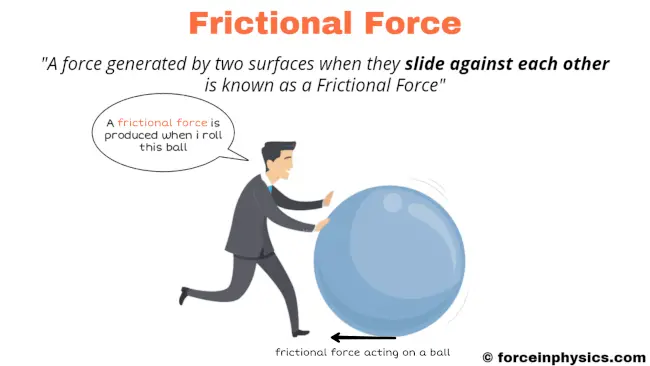
Friction is a force that occurs when two surfaces come into contact and slide or try to slide against each other. It acts opposite to the direction of motion or the applied force, effectively resisting the movement. The amount of friction depends on factors such as the roughness of the surfaces and the force pressing them together. Friction is crucial in everyday life as it affects the movement of objects and provides essential traction for various activities. For instance, when walking, friction between the shoes and the ground allows us to maintain stability and prevent slipping. In driving, the friction between the tires and the road enables proper control and maneuverability. Friction can also have negative effects, such as when it causes wear and tear on mechanical parts.
Examples
Matchstick
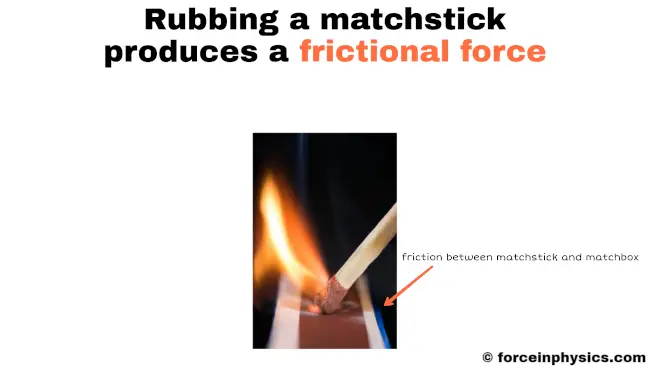
The friction between a matchstick and the rough surface of a matchbox plays a crucial role in igniting the matchstick. When vigorously rubbing the matchstick against the matchbox, the two surfaces slide and interact, creating friction. This friction generates heat and gradually increases the temperature of the matchstick’s head. As the heat reaches a critical point, it initiates a chemical reaction, causing the matchstick to ignite and produce a flame. This practical application of friction demonstrates how the conversion of kinetic energy into thermal energy can lead to ignition and the production of fire.
Pencil
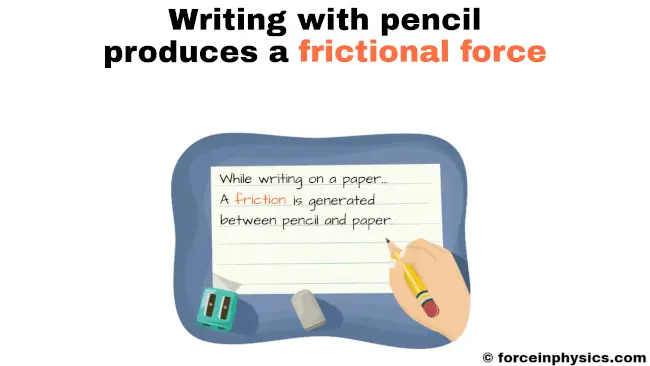
When we write with a pencil, the friction between its point and the writing surface is what enables us to make marks on the paper. As the pencil moves across the page, the point comes into contact with the surface and slides against it. This sliding motion generates friction, which allows the pencil to leave behind traces of graphite as it moves. The friction essential for transferring graphite onto the paper facilitates the creation of visible writing or drawing. Without the friction between the pencil and the writing surface, it would be difficult to make any marks or write legibly on the paper.
Mopping
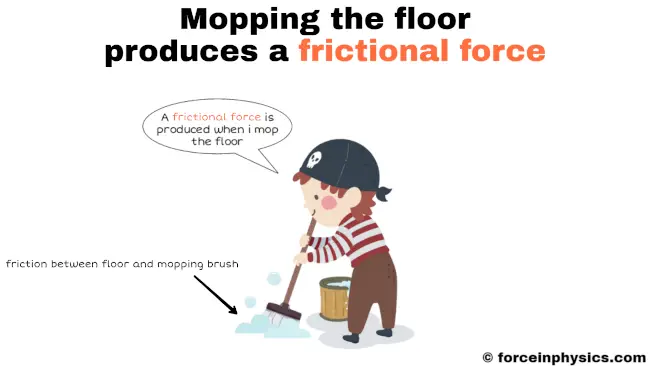
As the mop’s bristles or cleaning pad scrape against the floor, friction is generated between the two surfaces. This friction is vital for the effectiveness of the cleaning process as it enables the mop to grip the floor firmly. As the mop is moved back and forth, the friction between the mop and the floor surface plays a crucial role in dislodging and picking up dirt, dust, and other particles from the floor. Without the friction, the mop would not be able to effectively clean the floor and remove the unwanted debris.
Sandpaper rubbing
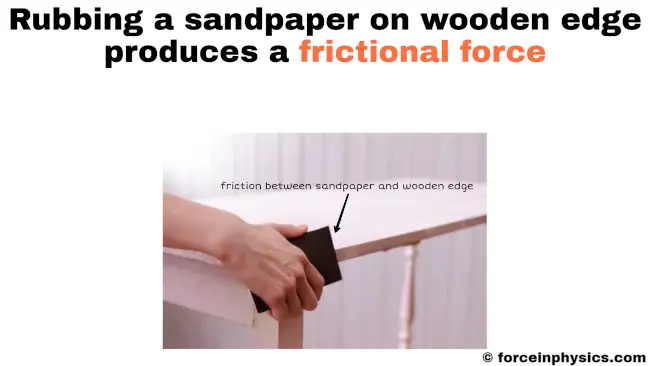
When a carpenter rubs sandpaper against a wooden edge to achieve a smoother surface, friction is generated between the sandpaper and the wood. As the sandpaper and wood surfaces slide against each other, this friction enables the abrasive surface of the sandpaper to effectively remove imperfections and roughness from the wood. The sandpaper’s abrasive action, made possible by the friction, helps the carpenter achieve a smoother and more refined finish on the wooden edge.
Eraser
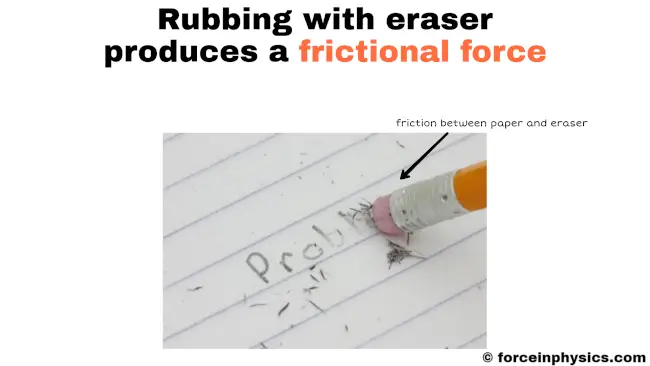
When using an eraser to remove pencil marks from paper, the contact and sliding motion between the eraser’s surface and the paper create friction. This friction helps to loosen and lift the pencil marks from the paper and makes them easier to erase. The eraser’s abrasive surface interacts with the graphite of the pencil marks, breaks the bonds, and allows the marks to be lifted away. Through the force of friction, the eraser effectively cleans the paper and leaves behind a smooth and clean surface.
Airplane
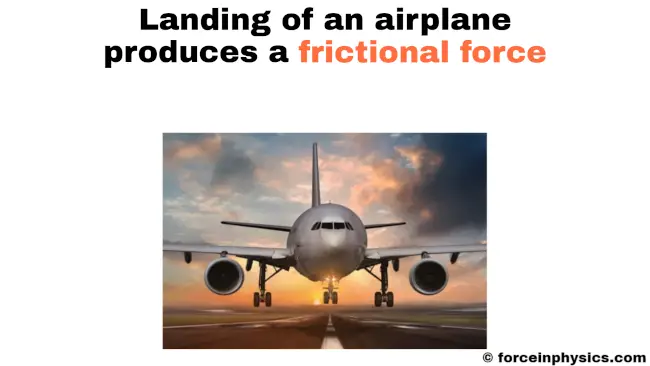
When an airplane descends to land on the runway, the frictional force plays a vital role in ensuring a safe landing. As the airplane’s wheels make contact with the runway surface, the interaction between the two creates friction. This frictional force opposes the forward motion of the airplane and gradually reduces its speed as it rolls along the runway. The strong friction between the wheels and the runway is necessary for the airplane to come to a complete stop safely and allows the pilot to control the landing process effectively. Without the force of friction, the airplane’s landing would be much more challenging, making it difficult to slow down and stop efficiently on the runway.
Cycling
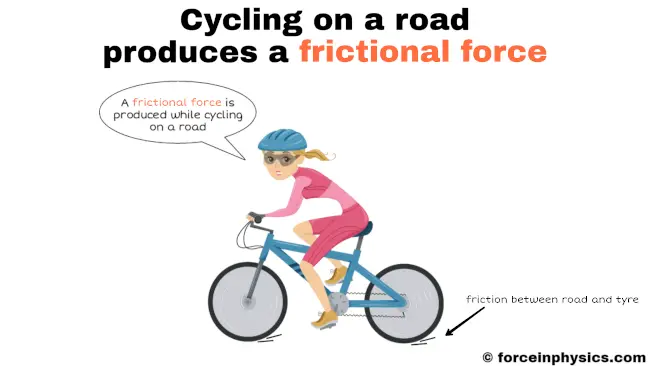
As a cyclist rides a bicycle on the road, friction comes into play between the tires of the bicycle and the road’s surface. When the bicycle moves forward, the tires make contact with the road, which leads to an interaction between their surfaces. This interaction generates friction, a force that resists the motion of the tires as they slide against the road. Friction is crucial for the tires to maintain a grip on the road and provide the necessary traction for the cyclist to control the bicycle and stay balanced while riding. Without friction, the tires would struggle to gain traction, making it difficult and unsafe to ride a bicycle on the road.
Chalk
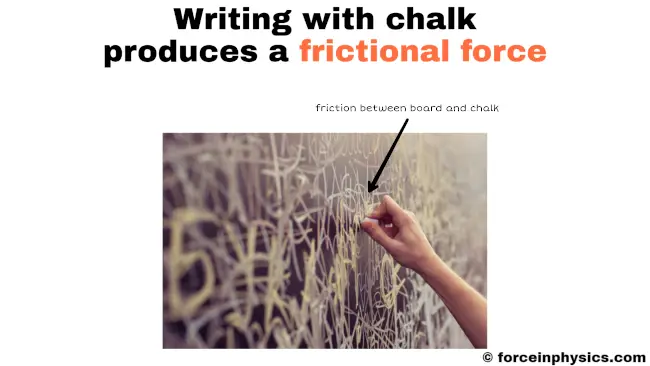
When writing with chalk on a blackboard, friction is created between the chalk’s tip and the blackboard’s surface. As the chalk is pressed against the blackboard and moved, their surfaces come into contact and slide against each other. This interaction leads to the generation of friction, which plays a significant role in leaving marks on the blackboard. The chalk’s abrasive texture, combined with the friction, allows it to leave a visible trail of writing on the blackboard’s smooth surface. The screeching sound often heard during this process is a direct result of the friction between the chalk and the blackboard, highlighting the dynamic interaction between these two surfaces.
Sled
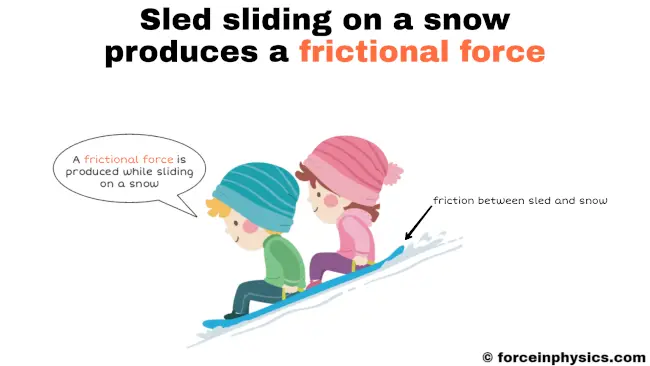
As a sled glides across the snow, it encounters friction between its surface and the snowy terrain. The interaction between the sled and the snow creates resistance, which leads to the generation of friction. This friction plays a crucial role in controlling the sled’s speed and ensuring a controlled sliding motion. Without friction, the sled would simply slide uncontrollably on the snow, making it difficult to steer or slow down. The presence of friction between the sled and the snow is essential for an enjoyable and safe sledding experience.
Shoe polish
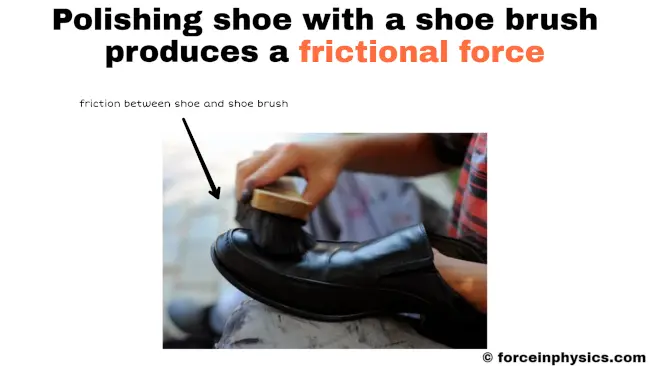
When a shoeshiner polishes a shoe with a shoe brush, friction comes into play as the shoe’s surface and the brush make contact and slide against each other. This interaction generates the necessary resistance to effectively shine the shoe. The bristles of the brush engage with the shoe’s surface, remove dirt and grime, and create a smooth and polished finish. Friction plays a pivotal role in this process. It allows the shoeshiner to achieve a clean and shiny appearance for the shoe and make it look well-cared-for and presentable. Without friction, the process of shining the shoe would be far less effective and efficient.
Hand rubbing
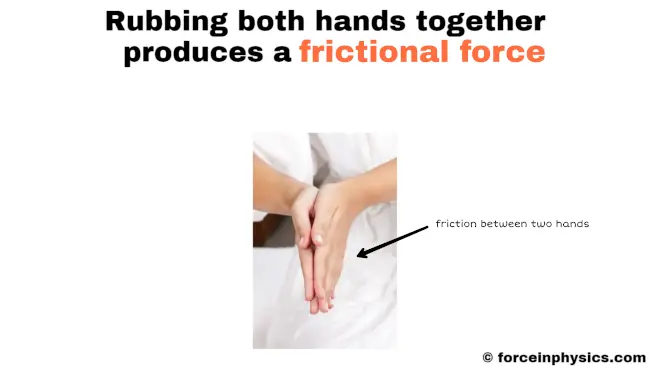
Rubbing hands together generates friction as the surfaces of the hands slide against each other. This rubbing action creates resistance and a feeling of traction between the rough areas of the skin and produces heat. It is a common method used to warm the hands, especially in colder environments. The friction between the hands converts the mechanical energy of the rubbing motion into thermal energy and provides a comforting and warming sensation. Without friction, this simple and effective method of generating warmth would not be possible.
Ironing
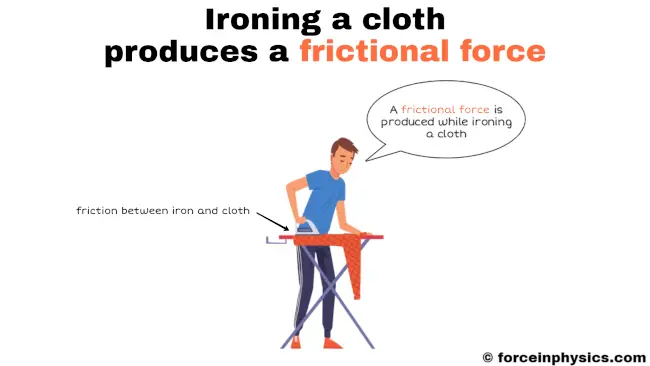
When ironing clothes, friction comes into play as the hot iron’s surface makes contact with and slides over the fabric. This interaction generates resistance and allows the iron to smoothly distribute its heat across the cloth. As a result, the fabric becomes wrinkle-free and creases are eliminated. This results in neat and well-pressed clothes. The friction between the iron and the fabric is essential in achieving the desired smooth and polished appearance.
Trolley
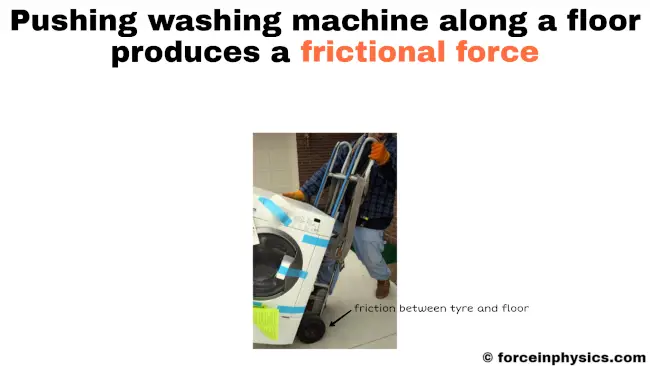
When pushing a trolley, friction is generated between the wheels of the trolley and the surface it is being pushed on. As the trolley moves, the wheels come into contact with the surface, and the interaction between these surfaces creates friction. This friction acts against the direction of motion and makes it more difficult to push the trolley smoothly. The resistance produced by friction is essential for the trolley to maintain traction and prevent it from slipping or sliding uncontrollably.
Skating
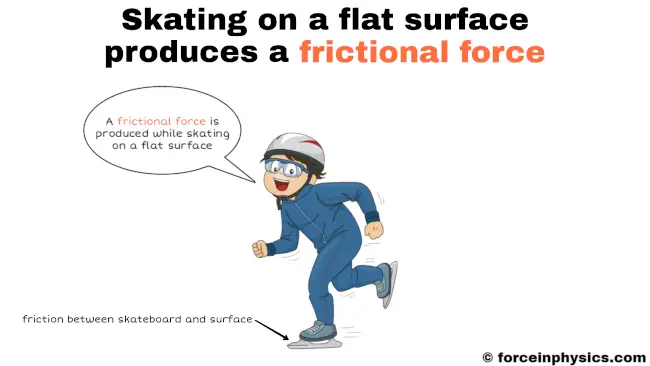
When ice skating, the blades of the skates come into contact with the icy surface. This results in the generation of friction. As the skater glides, the interaction between the skate blades and the ice creates resistance, known as friction. This friction opposes the skater’s forward motion, causing them to gradually slow down. Without friction, the skater would not be able to maintain control and balance while skating on the slippery ice.
Photocopier

When removing paper from a photocopier, friction comes into play as the paper slides against the surface of the photocopier. The interaction between the paper and the photocopier’s surface generates resistance, leading to the creation of friction. This friction hinders the smooth and easy removal of the paper. Consequently, some effort is necessary to overcome the resistance between the two surfaces. Without friction, paper would slide out effortlessly, and this could make handling and organizing documents difficult.
Sliding window
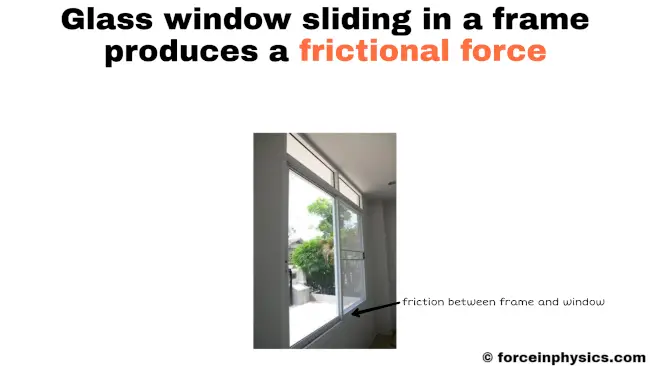
When a window is slid within its frame, friction arises between the window and the surface it slides upon. As the window moves back and forth, the two surfaces in contact experience friction and generate a resistance force. This friction serves a crucial purpose and allows the window to slide smoothly while maintaining enough resistance to keep it securely in place. Without friction, the window might slide too effortlessly, which leads to instability and difficulty in positioning.
Knife sharpening

When sharpening a knife on a sharpening stone, the blade of the knife makes contact with the surface of the stone and slides against it. This interaction between the two surfaces generates friction. As the blade moves across the stone, the friction helps to remove small bits of material from the knife’s edge. Over time, this sharpens it to a finer point. The abrasive action of the sharpening stone, facilitated by friction, allows for the restoration of a sharp cutting edge on the knife.
Garden slide
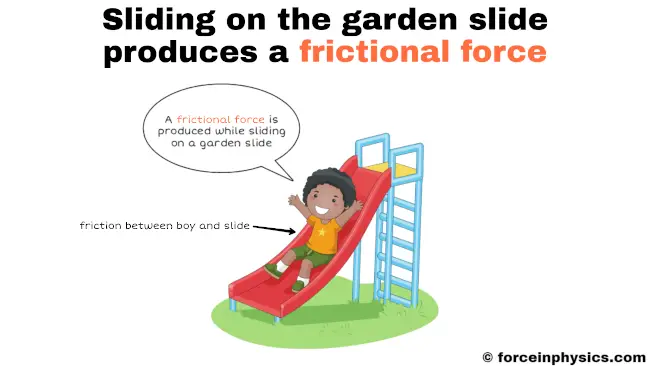
When someone descends a garden slide, the surfaces of their body and the slide come into contact and slide against each other. This interaction between the two surfaces generates friction. As they slide down, the friction acts as a resistance force, which gradually reduces their speed and provides control over the sliding motion. Thanks to the friction, the person can enjoy a smooth and controlled descent, ensuring a safe and delightful sliding experience. Without friction, the person would slide down too quickly. This makes managing speed difficult and could result in a less enjoyable or even unsafe experience. Therefore, friction significantly enhances the overall enjoyment and safety of using a garden slide.
Kitchen drawer
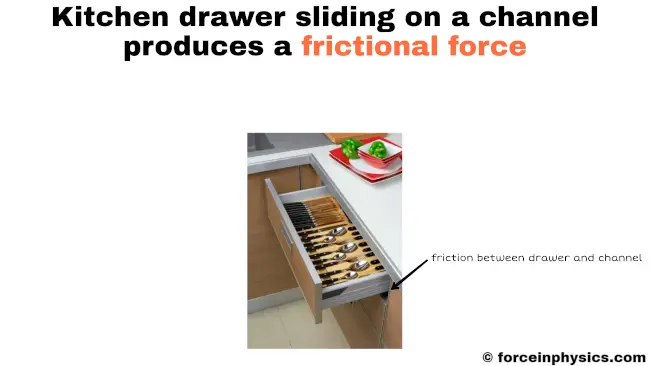
When opening or closing a kitchen drawer, friction comes into play as the surfaces of the drawer and the channel’s frame make contact and slide against each other. This interaction between the two surfaces creates friction, which is crucial for the smooth operation of the drawer. The friction provides the necessary resistance that enables controlled sliding and allows the drawer to move along the channel without slipping or skidding. It helps maintain stability and prevents the drawer from moving too quickly or too slowly, ensuring that it stays on its designated path. The presence of friction between the drawer and the channel’s frame is essential for the proper functioning of the kitchen drawer; it facilitates easy access to utensils, cutlery, or other items efficiently and without any disruptions.
Mirror
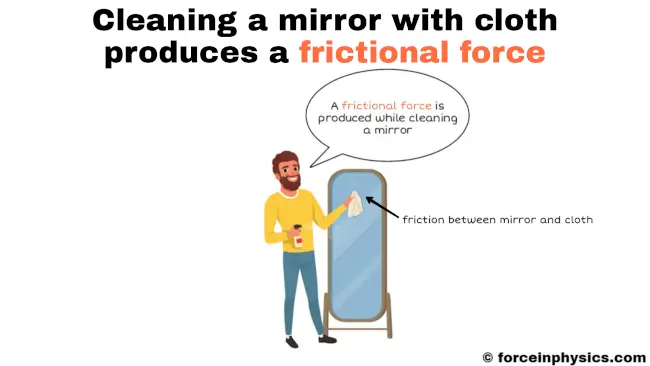
When cleaning a mirror with a cloth, the cloth’s fibers and the smooth surface of the mirror come into contact and slide against each other. This generates friction. This friction is essential for the cleaning process as it allows the cloth to effectively pick up dust, smudges, and other particles from the mirror’s surface. As the cloth glides across the mirror, the friction acts like a cleaning agent, and helps to dislodge and lift away any dirt or impurities. The interaction between the cloth and the mirror through friction enables thorough cleaning and leaves the mirror sparkling and free from any unwanted marks or debris.
Equation
The friction equation, represented as Ff = µ × FN, establishes a mathematical relationship between the friction force (Ff), the coefficient of friction (µ), and the normal force (FN). This equation is essential for calculating the magnitude of the frictional force acting on an object, considering both the coefficient of friction, which describes the nature of the surfaces in contact, and the normal force, which is the force perpendicular to the contact surfaces. By utilizing the friction equation, one can accurately determine the frictional force exerted during interactions between objects. This provides valuable insights into various physical scenarios and engineering applications.
Practice problems
Problem #1
Calculate the friction force acting on a 700 gm glass bottle as it is slid on a glass surface. The coefficient of friction between the glass bottle and the glass surface is 0.50.
Solution
Given data:
- Friction force acting on the glass bottle, Ff = ?
- Mass of the glass bottle, m = 700 gm = 0.7 kg
- Coefficient of friction between the glass bottle and the glass surface, µ = 0.50
- Assuming gravitational acceleration, g = 9.81 m/s2
Using the equation:
- Ff = µ × FN
- Ff = µ × mg (normal force equation, FN = mg)
- Ff = 0.50 × 0.7 × 9.81
- Ff = 3.43 N
Therefore, the friction force acting on the glass bottle is 3.43 N.
Problem #2
A laptop with a mass of 3 kg is placed on a desk and pushed with a hand. Calculate the friction force acting on the laptop, given that the coefficient of friction between the laptop and the desk is 0.18.
Solution
Given data:
- Mass of the laptop, m = 3 kg
- Friction force acting on the laptop, Ff = ?
- Coefficient of friction between the laptop and the desk, µ = 0.18
- Assuming gravitational acceleration, g = 9.81 m/s2
Using the equation:
- Ff = µ × FN
- Ff = µ × mg (normal force equation, FN = mg)
- Ff = 0.18 × 3 × 9.81
- Ff = 5.29 N
Therefore, the friction force acting on the laptop is 5.29 N.
Problem #3
Calculate the friction force acting on a wooden crate with a mass of 15 kg as it is pushed along a concrete floor. The coefficient of friction between the crate and the floor is 0.15.
Solution
Given data:
- Friction force acting on a wooden crate, Ff = ?
- Mass of a wooden crate, m = 15 kg
- Coefficient of friction between the crate and the floor, µ = 0.15
- Assuming gravitational acceleration, g = 9.81 m/s2
Using the equation:
- Ff = µ × FN
- Ff = µ × mg (normal force equation, FN = mg)
- Ff = 0.15 × 15 × 9.81
- Ff = 22.07 N
Therefore, the friction force acting on a wooden crate is 22.07 N.
Problem #4
Determine the value of the friction force acting on a metal sheet with a mass of 8 kg as it is pulled along a wooden floor. The coefficient of friction between the metal sheet and the wooden floor is 0.20.
Solution
Given data:
- Friction force acting on a metal sheet, Ff = ?
- Mass of a metal sheet, m = 8 kg
- Coefficient of friction between the metal sheet and the wooden floor, µ = 0.20
- Assuming gravitational acceleration, g = 9.81 m/s2
Using the equation:
- Ff = µ × FN
- Ff = µ × mg (normal force equation, FN = mg)
- Ff = 0.20 × 8 × 9.81
- Ff = 15.69 N
Therefore, the friction force acting on a metal sheet is 15.69 N.
Related
- Balanced force
- Unbalanced force
- Friction
- Tension (physics)
- Applied force
- Normal force
- Drag (physics)
- Gravity
- Centripetal force
- Centrifugal force
- Buoyancy
- Net force
- Compression (physics)
More topics
External links
- Friction – Wikipedia
- Friction | Definition, Types, & Formula – Britannica
- What is friction? – Live Science
- What is friction? (article) – Khan Academy
- Explainer: What is friction? – Science News Explores
- Friction Definition & Meaning – Dictionary.com
- 5.1 Friction – College Physics 2e – OpenStax
- Friction Definition & Meaning – Merriam-Webster
- Force – HyperPhysics Concepts
- FRICTION – Cambridge English Dictionary
- Friction – an overview – ScienceDirect
- Friction – Springer
- 5.1 Friction – College Physics – UCF Pressbooks
- What is friction and how does it work? – BBC
- friction – Wiktionary
- Friction – Boston University
- Friction for Kids – DK Find Out!
- Friction Overview, Types & Measurement – Video & Lesson Transcript – Study.com
- Friction – Ducksters
- Types of Friction (Read) | Physics – CK-12 Foundation
- Friction (Frictional Force): Definition, Formula, & Examples – Science Facts
- Friction and resistance – TheSchoolRun
- Friction: Explanation, Review, and Examples – Albert
- Forces of Friction – GitHub
- Friction – Definition, Meaning & Synonyms – Vocabulary.com
- What Even Is Friction, Anyway? – Wired
- Friction definition and meaning – Collins Dictionary
Deep
Forceinphysics.com was founded by Deep Rana, who is a mechanical engineer by profession and a blogger by passion. He has a good conceptual knowledge on different educational topics and he provides the same on this website. He loves to learn something new everyday and believes that the best utilization of free time is developing a new skill.
